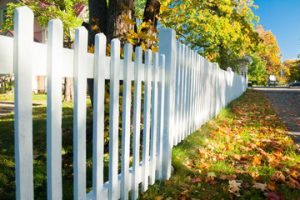Professional fence contractors prioritize quality assurance to ensure that the final product exceeds clients’ expectations. They also work to ensure that the project complies with zoning regulations and building codes.

When choosing a fence contractor, make sure to ask about their experience, review their past projects, and verify their credentials and insurance coverage. You can also ask for references from past customers. Contact Fence Contractors Port St Lucie for professional help.
Choosing the right fence contractor for your project is an important step to ensure that your project proceeds smoothly and efficiently. A reputable and experienced company will put a strong emphasis on client communication and satisfaction, providing updates, addressing questions or concerns, and ensuring that the work is being done in accordance with plans and specifications. It is also advisable to have a legal professional review any contract to ensure that your interests are adequately protected.
After a thorough consultation, your fence contractor will provide an accurate estimate for the project. They will take into account factors such as the desired fence height, materials, and any additional features like gates or access control systems. This will give you a better idea of the total cost of the project and help you to plan accordingly.
Before starting the installation process, your fence contractor will mark utility lines and clear obstructions from the area where the new fence is to be built. They will also check with local zoning laws and building codes regarding fence construction to avoid potential issues or delays in the future. This research is vital for residential property owners because different municipalities have specific regulations that govern fence height, placement, and materials.
Once the site has been prepped, contractors will begin digging holes for posts and laying out the fence line according to design plans. They will use specialized equipment and machinery to dig and set each post, which are usually secured with concrete for stability. After the posts are in place, they will affix the fence panels or boards. The exact procedure will vary depending on the chosen materials, but skilled installers work methodically to achieve flawless connections and uniform spacing.
Once the installation is complete, your fence contractor will add any final touches like gates or decorative caps and inspect the work to ensure quality standards are met. They will also offer maintenance tips to ensure that your new fence stays in tip-top shape for years to come.
Consultation
When hiring fence contractors, it is critical to consider their experience and expertise. Look for a company that has extensive industry knowledge and offers an array of quality products to meet your specific needs. Ask potential providers about their track record, methodological approach to projects, expected timelines and warranty provisions. It is also important to clarify your goals for the project so that they can align their services with your needs, including security, privacy, aesthetics and boundary definition. Determining what your needs are can help you prioritize features and define a budget.
Once you’ve narrowed down your options, request quotes from several contractors to compare prices and services. A thorough estimate should include all costs related to the installation, including labor and materials. It is also a good idea to consider the availability of specific fencing materials such as steel fence panels. Be wary of unusually low quotes, which may indicate that the contractor is cutting corners to save money or sacrificing quality for profitability.
During the consultation process, professional fence contractors conduct a detailed evaluation of your property, assessing its unique attributes. This assessment helps them identify the best location for the fence and address any logistical or regulatory concerns that might affect construction. For example, some localities require that the construction site be cleared of obstructions like trees and rocks before beginning work. In addition, there may be buried utility lines that must be located before construction begins.
Depending on your situation, the consultation process can also serve as an opportunity to gather recommendations from trusted friends and family members. You can also examine portfolios of completed projects to assess a contractor’s craftsmanship and attention to detail. It is also important to ask potential contractors about their membership in professional associations, licensing details and insurance coverage.
It is also a good idea to speak with your neighbors about the fence project. Be honest about your intentions so that your neighbors can expect construction to cause some disruptions. Moreover, you should let them know how long the construction will take so that they can plan accordingly.
Design
The design process is a vital aspect of any fence construction project. During this phase, professionals guide homeowners through the myriad options available, explaining the pros and cons of each material. Then, they carefully craft a solution that best fits their needs and aesthetic vision. Ultimately, this process results in a durable, high-quality fence that enhances the home’s overall value.
In many instances, the design process also involves navigating local regulations. For instance, some areas require homeowners to obtain a permit before beginning construction. This is often necessary for fences that exceed a certain height, as it ensures that the structure is safe and complies with local zoning laws. In addition, it’s important to conduct a thorough survey of the property to ensure that all required measurements are accurate.
Next, the professional will evaluate the site conditions to determine if they are suitable for a new fence. This includes assessing the soil type and condition, as well as taking into account any existing structures or vegetation. This is a crucial step that can make the difference between a successful project and one that ends up costing more time and money than expected.
Once the final design has been determined, the work can begin. This begins with clearing the area where the fence will be installed and removing any obstructions. It’s also important to mark out the location of the fence posts, which will serve as the foundation for the entire structure.
The installation process can be challenging, particularly when dealing with complex, multi-level fences. Professional contractors are equipped with the tools and knowledge needed to complete the job quickly, safely, and to the highest standards. They will also take care to maintain a clean worksite and respect the privacy of neighbors, which can be especially important for homes located on a busy road or in a residential neighborhood.
In addition to constructing high-quality fences, professionals also provide customized solutions for commercial properties. This may include incorporating logos, decorative elements, or unique designs into the fence, which can enhance curb appeal and strengthen brand identity.
Materials
A professional fence contractor will be familiar with local building codes and regulations, ensuring your new fence is built according to the law. They will also have the knowledge to advise you on the best materials for your property and design preferences. In addition, a fence contractor will know how to adapt your design to the local climate. This is important in Plano, where harsh weather conditions can impact the durability of different types of fencing material.
A quality fence can increase your property’s value by increasing security and enhancing its aesthetic. In order to make sure you’re choosing the right contractor, ask them about their experience with the type of fencing you want to install and the types of projects they’ve worked on in the past. Also, be sure to ask about their warranty and guarantee policies.
Whether you’re looking for a privacy wood fence installation or a decorative wrought iron fence, the right contractor will ensure that your new fence is constructed using high-quality materials and finished properly. They will use a variety of tools and materials to create a functional, stylish, and durable fence. They will also use quality cement to bind the posts and rails together. Fence contractors will also use a variety of post caps to add a decorative touch to your new fence.
Line posts: These are the upright supports that run along the length of the fence. Fence contractors will erect these posts at regular intervals throughout the fence, forming a strong and sturdy base. Corner posts: These are placed at the corners of your fence where two sections meet. Fence contractors will erect these at the corners of your fence where two sections of fence panels or rails meet, creating a secure and attractive finish to your new fence.
A fence made from wood is a popular choice for many properties because of its natural beauty and longevity. Fence contractors can use a wide range of wood options for your new fence, including cedar, pine, and treated lumber. Cedar is a particularly durable and affordable option. It’s also a great choice for homeowners because it is easy to maintain and looks good in almost any environment. In addition, the natural oil in cedar makes it resistant to moisture, and it can be stained or painted to match any home’s decor.
